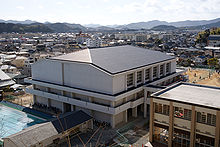List of building types
This is a list of building types. It is sorted by broad category: residential buildings, commercial buildings, industrial buildings, and infrastructural buildings.
Residential
[edit]Single-family detached
[edit]Examples of single-family detached house types include:
- Bungalow
- Central-passage house (North America)
- Chattel house (Caribbean)
- Château (France)
- Cottage (various)
- Courtyard house (various)
- Konak (Asia)
- Log house (various)
- Mansion (various)
- Housebarn (various)
- Split level home (various)
- Upper Lusatian house (Europe)
Single-family attached (small multi-family)
[edit]- Duplex, semi-detached, double-decker, or two-family
- Triplex, triple-decker or three-family
- Quadplex, quadruple, or four-family
- Townhouse or terraced house
Large multi-family (apartments/flats/condos)
[edit]
- Garden or walk-up apartments: 1–5 stories, 50–400 units, no elevators[1]
- Mid-rise apartments/condos: 5–9 stories, 30–110 units, with elevators[1]
- High-rise apartments/condos: 9+ stories, 100+ units, professionally managed[1]
- Special-purpose group housing[1]
Public
[edit]Commercial
[edit]Commercial buildings, generally, are buildings used by businesses to sell their products to consumers.[1]
Office
[edit]
Office buildings are generally categorized by size and by quality (e.g., "a low-rise Class A building")[2]
- Office buildings by size
- Low-rise (less than 7 stories)
- Mid-rise (7–25 stories)
- High-rise (more than 25 stories), including skyscrapers (over 40 stories)
- Office buildings by quality[3][4]
- Trophy or 5-star building: A landmark property designed by a recognized architect
- Class A or 4-star building: Rents in the top 30-40% of the local market; well-located; above-average upkeep and management; usually older than a trophy/5-star building
- Class B or 3-star building: Rents between Class A and Class C; fair-to-good locations; average upkeep and management
- Class C or 2-star building: Rents in the bottom 10-20% of the local market; less-desirable locations; below-average upkeep and management
- 1-star building: Does not meet the needs of typical tenants; may be obsolete and/or in need of significant renovation[3]
Retail
[edit]Retail buildings are categorized by their configuration and size[5]

- Non-freestanding (also known as shopping centers or shopping malls)
- Super-regional shopping center: enclosed space; 800,000+ sqft; 5+ anchor stores with other tenants that sell a very large variety of goods
- Regional shopping center: enclosed space; 400,000–800,000 sqft; 1–5 anchor stores with other tenants that sell a large variety of goods
- Community shopping center: open space; 125,000–400,000 sqft; provides general merchandise and commodities (e.g., supermarket, discount department store)
- Neighborhood shopping center: open space; 3,000–125,000 sqft; provides commodities to nearby neighborhoods (e.g. drug store)
- Strip or convenience shopping center: open space; less than 30,000 sqft; located along suburban transportation arteries on shallow land parcels; a strip may be configured in a straight line, or have an "L" or "U" shape
- Lifestyle center: "Main Street" concept with pedestrian circulation in core and vehicular circulation along perimeter; upscale national chain specialty stores, dining or entertainment (e.g. The Grove, Los Angeles, CA; Americana at Brand, Glendale, CA)
- Freestanding: any stand-alone retail structure that is not part of a complex
- Big box: freestanding category-dominant retailer; 50,000+ sqft (e.g. The Home Depot, Target, Walmart)
- Power center: among the largest types of retail properties; 3+ big box anchor stores; multiple large buildings with parking lot in front and loading in back; smaller retailers usually clustered in a community shopping center configuration
- Retail outlet: manufacturers' outlet stores; 50,000–400,000 sqft
- Pop-up retail: a retail location designed to only be in a location temporarily (e.g., a retail store that only opens during a holiday season)
Hotels
[edit]
- Full service hotel
- Travelers' hotel
- Extended stay hotel
- Boutique hotel
- Casino
- Resort
- Bunkhouse
Special-purpose
[edit]
- Theme or amusement park
- Aquarium
- Bar (establishment)
- Bowling alley
- Car wash
- Funeral home
- Marina
- Movie theater
- Self-storage
- Theater
- Zoo
Industrial
[edit]Industrial buildings are primarily used for the production and storage/distribution of goods, among other uses.[6]
Manufacturing
[edit]
Warehouse/distribution
[edit]
Flex space
[edit]Infrastructure
[edit]
Infrastructure buildings house equipment and facilities related to public infrastructure.
- Composting
- Desalination plant
- Waste transfer
- Power generation
- Power distribution
- Transmitter building
- Dams
- Pump house
- Fake building
Agricultural
[edit]Institutional
[edit]
- Medical
- Educational
- Academy
- Archive
- College
- Elementary schools
- Middle school
- Orphanage
- Secondary School
- School
- University
- Nursery school

A mudhif near Lagash, Iraq
- Civic
- Arena (or stadium)
- Library
- Mudhif: a traditional reed house made by the Madan people of Iraq
- Museum
- Observatory
- Community hall

A monastery in the Sinai Peninsula, Egypt - Research institute
- Religious Facilities (Place of worship)
- Government
- Military
- Arsenal
- Barracks
- Bunker
- Blockhouse
- Citadel
- Missile launch facility

A spacepad in Baikonur, Kazakhstan
- Transport
- Airport
- Bus station
- Metro (subway, underground) station
- Taxi station
- Railway station (or, primarily in US, Railroad station)
- Lighthouse
- Shipyard
- Spaceport
- Hovercraft
- Passenger terminal
- Boathouse
- Parking garage
- Hangar

A gym in Tatsuno, Hyōgo Prefecture, Japan
- Historical
- Other
Other
[edit]See also
[edit]![]() Media related to Buildings by function at Wikimedia Commons
Media related to Buildings by function at Wikimedia Commons
References
[edit]- ^ a b c d e Schmidt, Robert (2018-11-25). "Types of Commercial Real Estate". PropertyMetrics. Retrieved 2018-11-25.
- ^ Sicola, Maria (March 2017). "Office Terminology". Commercial Real Estate Terms and Definitions (PDF). The NAIOP Research Foundation. pp. 27–31.
- ^ a b "CoStar Building Rating System" (PDF). CoStar.
- ^ Kugler, Thomas. "Building Owners and Managers Association (BOMA) International". Building Owners and Managers Association (BOMA) International. Retrieved 2018-11-25.
- ^ Sicola, Maria (March 2017). "Retail Terminology". Commercial Real Estate Terms and Definitions (PDF). The NAIOP Research Foundation. pp. 32–36.
- ^ Sicola, Maria (March 2017). "Industrial Terminology". Commercial Real Estate Terms and Definitions (PDF). The NAIOP Research Foundation. pp. 21–26.







